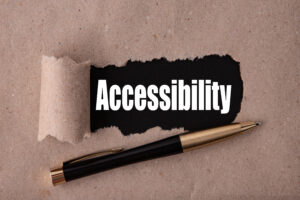As a web designer, you probably already know how web accessibility helps web users and improves your client’s business. But did you know designing accessible websites also has numerous benefits for you? Find out why investing in web accessibility is well worth your time and effort.
Great web design goes beyond the aesthetics of using beautiful color schemes or nice fonts. As former Microsoft CEO Steve Balmer puts it,
“Accessible design is good design – it benefits people who don’t have disabilities, as well as people who do. Accessibility is all about removing barriers and providing the benefits of technology to everyone.”
Does this mean a website should be ugly-looking? Of course not! But what is far more important is that the website is easy to use and supports the general needs of its users (all of them).
Unfortunately, a lot of websites on the Internet are not designed to be accessible. As a result, millions of people in the United States (and billions in the world) have difficulties finding and engaging with online content.
Web designers can benefit from fixing these issues and making the Internet more accessible to everyone.
So, how can web designers benefit from fixing these issues and making the Internet more accessible? Let’s consider a few.
Are you a web designer? Want to gain an edge over the competition?
Offer your clients web accessibility in a few easy steps and earn a 20% commission with Equally AI’s Partner Program.
5 Ways Web Accessibility Benefits Web Designers
1. Protects You And Your Clients From Fines
In the U.S., disability laws such as the Americans with Disabilities Act (ADA) and Section 508 of the Rehabilitation Act protect the rights of people with disabilities to public spaces. Other countries in the world also have their own laws on web accessibility. As a designer, you and your clients risk getting sued if the websites you design are not accessible.
“But these laws do not apply to web designers because they do not own the websites they create”, you may say.
Well, that’s true. But you may be liable under the terms of agreement in the contract you signed with your client. Most companies’ contracts contain accessibility clauses on accessibility which mandate you to design accessible websites. If your client gets sued for having an inaccessible website, they may bring their own lawsuit against you.
2. Increases Market Reach And Revenue

Web accessibility standards and guidelines are not just for people with disabilities. Their purpose is to ensure everyone has equal access to the internet and a great online experience. Everyone benefits from a website that is intuitive and compatible with whatever device, browser or assistive technology they use.
Interestingly, people with disabilities are likely to be loyal customers of companies that prioritize accessibility. Plus, the market segment of people with disabilities has huge spending power. Designing accessible websites creates a domino effect of increased returns (from your clients to you).
3. Improves the Quality of Your Services
Providing great user experiences should always be the top priority in designing a website. You want your website to be as user-friendly as possible for everyone. If it’s great to look at, but some people (for example, assistive technology users) cannot navigate it, then it’s not a good website.
Improving user experience is not only for the convenience of people who use the website. It is also an important factor in helping you or your client increase traffic, conversions, and of course, revenue.
4. Establishes You As An Expert in Your Field
Accessibility gives you a special area of expertise that many designers lack. In recent years, more companies are getting concerned about being accessible due to the increase in website accessibility lawsuits. Being a web designer with knowledge of accessibility places you in a unique position to provide expert services that help your clients save money and reputation.
Remember, when you design accessible websites, you help people with disabilities enjoy equal access to information, services, and resources online. By doing this, you will improve your reputation as a web designer and that of the business that owns those sites.
5. Gives You An Excellent Selling Point
As earlier mentioned, having accessible web design skills gives you an edge over the competition. This can increase your negotiating power whether as a freelancer or employee.
Besides helping your clients or employer avoid lawsuits, you have the ability to help them expand their market reach and improve reputation and customer satisfaction. That’s a lot of value you’re providing, which increases your value as a service provider.
Read also: Why Web Accessibility Matters
How Web Designers Can Improve Accessibility
1. Proper Use of Colors and Contrast
2. Proper Use of Typography and Font Size
3. Text Alternatives for Images and Media Content
Website media (images, videos, audio files) must be accessible to all users. Provide alternative text for images and images of text to help assistive technology users fully experience and understand them. Similarly, including captions, subtitles, and transcripts for audio and video content benefits all users (with or without disabilities) .
4. Designing For Mobile Accessibility
Bottom Line - What's next?
Web accessibility benefits not only people who own or use the website but also those who design them. Web designers who create with accessibility in mind provide real value to end-users and businesses.
Equally AI’s Partner Program helps you offer web accessibility to reach more clients, offer valuable services, and gain an advantage over your competitors.




